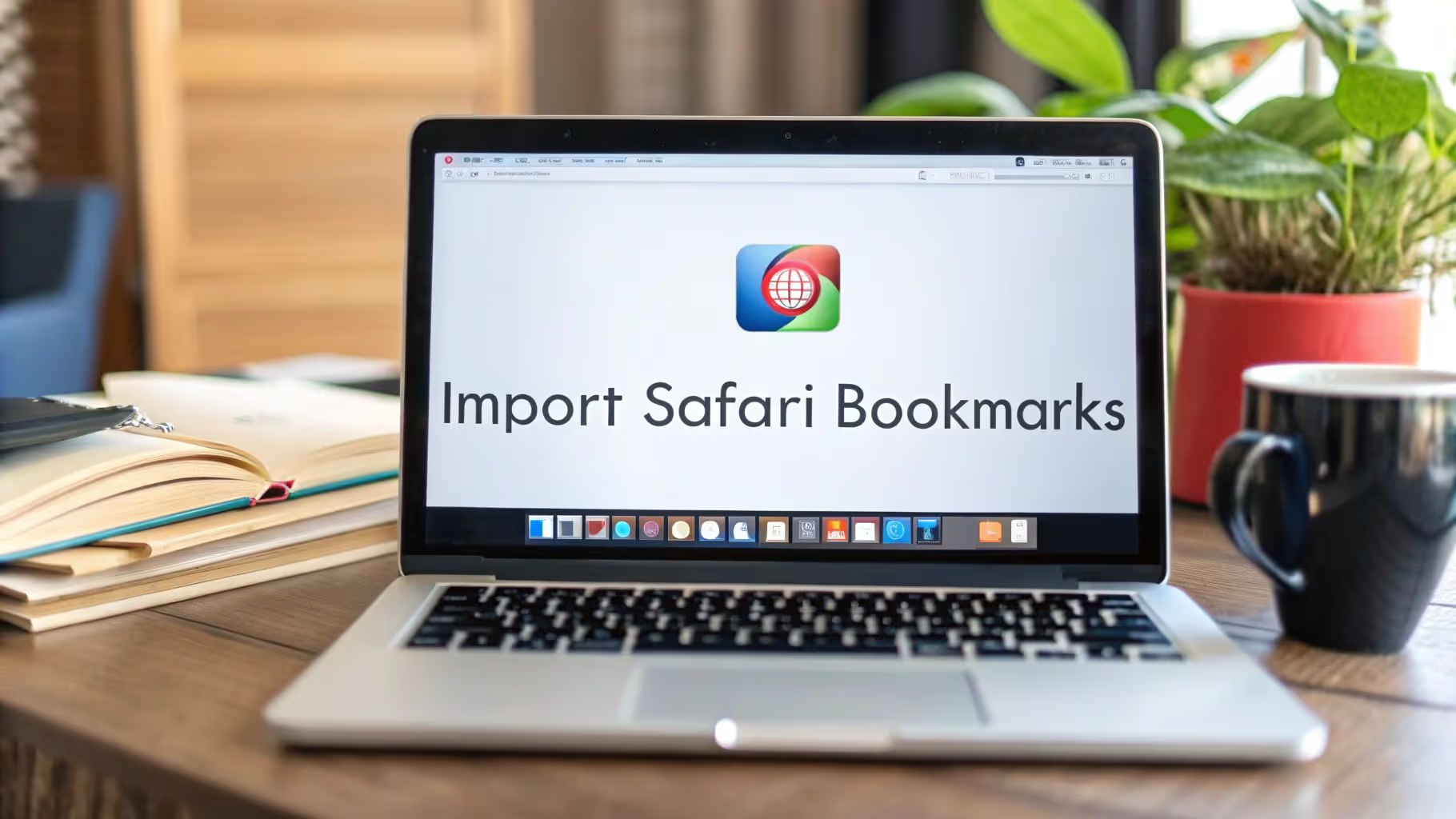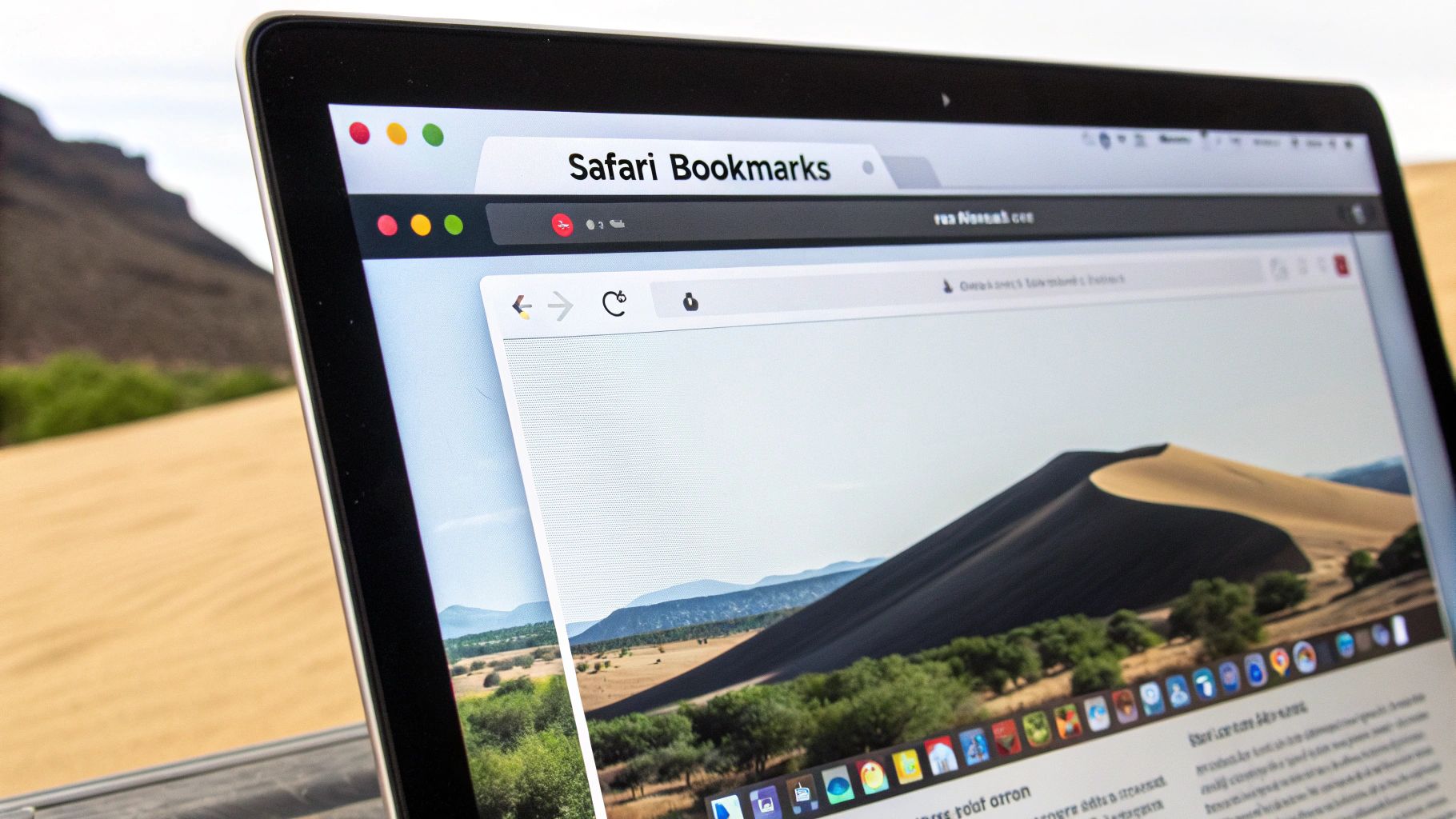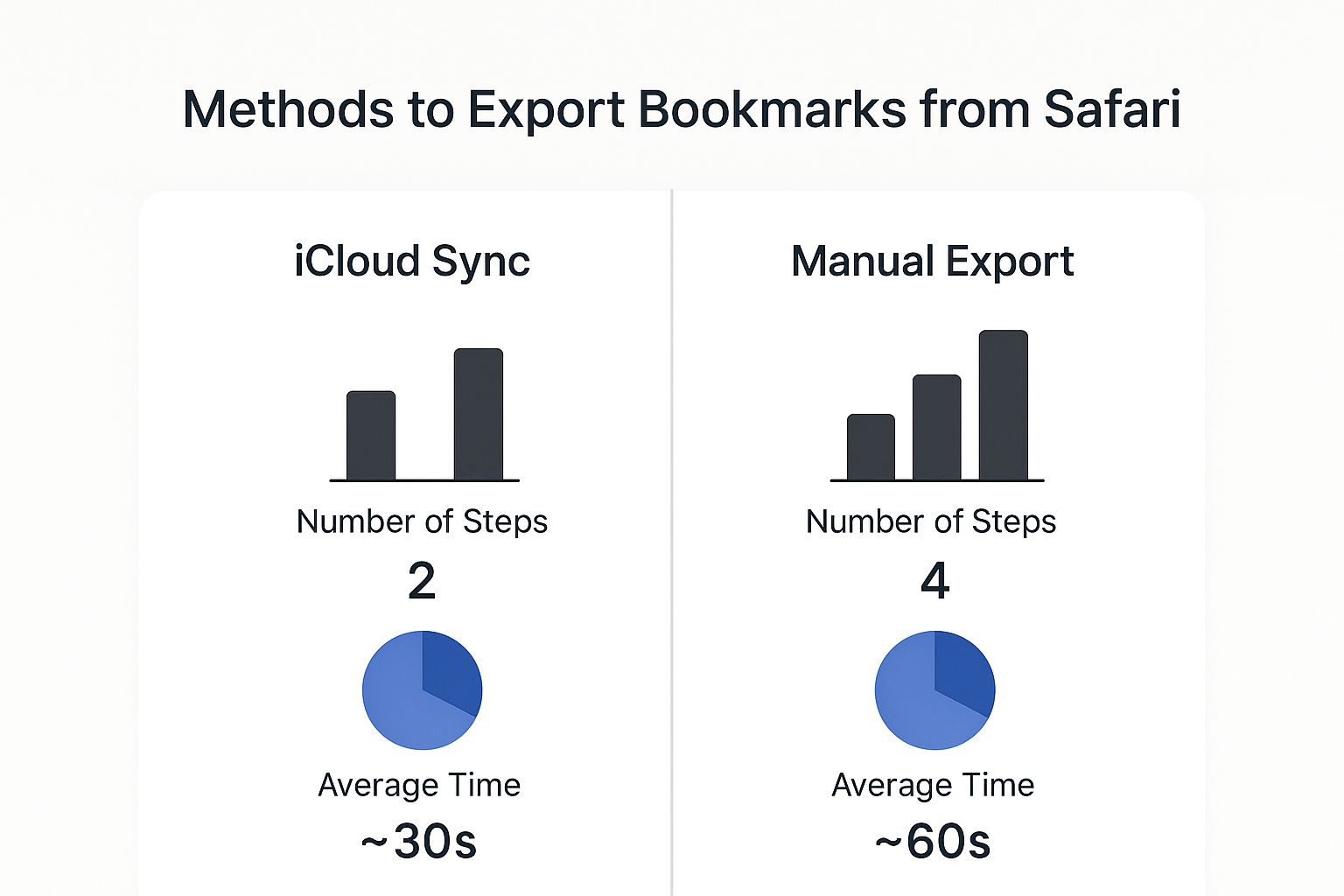How to Import Bookmarks Safari to Chrome Easily
Learn how to import bookmarks Safari to Chrome quickly and effortlessly with our step-by-step guide. Simplify your browser migration today!
November 29, 2025

Ivan S
Founder @bookmarkify

Learn how to import bookmarks Safari to Chrome quickly and effortlessly with our step-by-step guide. Simplify your browser migration today!
November 29, 2025

Ivan S
Founder @bookmarkify


Let's be real, you're probably here because Safari just isn't cutting it anymore. I get it – I've helped tons of people make this same switch. I've noticed some common frustrations: Maybe Safari's limited extensions are holding you back, or the syncing between your devices is spotty. Perhaps websites just don't render right, or you're missing Chrome’s powerful developer tools.
These are all perfectly good reasons to think about importing your Safari bookmarks to Chrome. Chrome's rock-solid password management and seamless integration with Google Workspace are total game changers. After you've got those bookmarks imported, a great way to level-up your browsing is by exploring Chrome extensions for productivity. Seriously, it opens up a whole new world of customization.
Now, let's talk about privacy and performance. Chrome's gotten some flak in the past, but so has Safari. In my experience, with the right settings, Chrome runs like a dream. Plus, that huge library of extensions includes some really great tools for boosting your privacy.
And when it comes to market share, Chrome is king, sitting at about 67.08% globally as of January 2025, compared to Safari's 18.35%. This highlights just how important bookmark importing really is. It's especially relevant in the U.S., where Safari holds a significant 32.4% of the market, making the ability to easily transfer bookmarks even more crucial for anyone switching over to Chrome. You can find more interesting data on this over at Soax's browser market share research. At the end of the day, choosing a browser is a personal thing, but understanding the pros and cons can help you make the best decision for you.
Before we jump into importing your bookmarks from Safari to Chrome, let's get organized. A little prep work in Safari will save you a lot of frustration later. Seriously, I learned this the hard way. It's like moving to a new apartment – a little packing strategy goes a long way.
First, let's tackle those duplicate bookmarks. Safari has a "Show Duplicates" command (Bookmarks menu) that makes this super easy. Then, get rid of any dead links. Broken bookmarks are just digital clutter. There are even some helpful extensions that can automate finding broken links for you. For some extra organization inspiration, check out some resources on social bookmarking websites.
Now, consider your bookmark structure. Do you have folders nested five levels deep? While Chrome can handle it, sometimes things get a little messy during the transfer. Simplifying your Safari bookmarks before importing can prevent future headaches, especially if you're using Safari-specific features that won't transfer. For example, Safari's Reading List works differently than Chrome bookmarks.
Speaking of which, let's talk backups! Even if everything goes smoothly (and it usually does), a backup is always a good idea. Safari can export your bookmarks as an HTML file. This isn't just for switching to Chrome; it's a lifesaver if anything goes wrong with your browser. Importing bookmarks from Safari to Chrome is pretty common, especially with Safari having about 22.89% of the mobile browser market (as of February 2025). With so many potential Safari users switching, having a backup is crucial. You can learn more about browser market share here. Take a few minutes to back things up; you won't regret it!

This infographic gives you a quick visual comparison of two common ways to get your bookmarks out of Safari: iCloud Sync and a Manual Export. Notice how iCloud Sync usually wins for speed and simplicity? That efficiency can be a lifesaver, especially if you’re constantly tweaking your bookmarks.
Let’s talk about Chrome’s built-in import tool. It’s surprisingly good, but most guides barely scratch the surface. I'll share the little details that can make the difference between a smooth import and a total headache. Trust me, I've been there!
First, find the import wizard. It’s hiding in Chrome’s settings under Bookmarks then Import bookmarks and settings. Choosing "Safari" is crucial—double-check it's the correct Safari profile if you have multiple user accounts on your machine.
Chrome will likely ask for permissions. Don't just click "Allow"—actually look at what access you're giving and adjust it if needed. This is where I see a lot of folks trip up and end up with only some of their bookmarks.
There are also some less obvious settings that control exactly what gets imported. Don’t ignore these! You might not want everything to come over. Some Safari-specific things, like Reading List entries, might not translate perfectly into Chrome.
Your internet connection matters, too. A slow or flaky connection can mess things up, so make sure you're on a stable network. The whole process of moving bookmarks between browsers like Safari and Chrome relies on what the browsers themselves can do. Chrome, with its huge library of extensions, offers a bunch of tools to make this easier. For example, Chrome’s built-in bookmark manager lets you easily import bookmarks from other browsers (including Safari) using the ‘Import bookmarks and settings’ feature. Learn more about Chrome statistics here. This really shows how flexible Chrome is for managing bookmarks, especially if you're switching from another browser.
Before you move on, verify the import. Don't assume everything went perfectly! Check your bookmarks bar and the bookmark manager. Look for anything that’s missing. If something's wrong, no worries—we'll get to troubleshooting later.
To help you pick the best approach, I've put together a comparison table:
Import Method Comparison: Built-in vs Third-Party Tools
This table summarizes the pros and cons of different methods. As you can see, the built-in tool is generally reliable and quick. Third-party extensions can be helpful in specific situations, but their effectiveness varies. iCloud Sync is the fastest, but it requires using iCloud.
Picking the right way to import your bookmarks can save you a ton of time and frustration. By understanding the nuances of each method, you can ensure a smooth transition and keep all your favorite sites organized.

Sometimes, importing bookmarks from Safari to Chrome just doesn't cooperate. Older macOS versions, corrupted Safari data, or even user account switches can mess things up. Don't panic! I've been there, and these are the tricks I use to get those bookmarks moved.
One of my go-to methods is Safari's HTML export. It's a bit tucked away, but super useful. Safari can save your bookmarks as an HTML file, creating a perfect package for Chrome to import. In Safari, go to File > Export Bookmarks. Save the file somewhere handy. Then, in Chrome, head to the import wizard (Bookmarks > Import bookmarks and settings) and select that HTML file. Boom! Bookmarks saved. This has rescued me more times than I can count.
Another great option is using a third-party bookmark manager. These tools are especially useful if you want to tidy up your bookmarks during the move. It's like moving houses – pack, sort, then unpack. Many bookmark managers can import from Safari and export to Chrome, acting as a perfect middleman. For some recommendations, check out this article: The Best Way to Organize Bookmarks.
If you're a power user with a complex bookmark structure, manual migration might be your best friend. This means directly copying bookmarks from Safari's bookmark file to Chrome's. It's a bit more technical, but it gives you total control. Think of it as carefully labeling every moving box so you know exactly where it goes. This method is perfect for keeping your carefully organized folders exactly how you want them.
This might sound strange, but Firefox can actually help! If the direct Safari-to-Chrome transfer isn't playing nice, try importing your Safari bookmarks into Firefox first. Then, export them from Firefox as an HTML file, and finally import that into Chrome. It's like taking a connecting flight when there's no direct route.
One final tip: watch out for special bookmark types like Reading List items. These can be tricky and might not transfer perfectly. You might have to manually recreate them in Chrome or find a workaround. It's a little extra effort, but it’s worth it to keep everything organized. With these strategies, you're equipped to handle any bookmark migration challenge!
Migrating your bookmarks from Safari to Chrome can sometimes hit a few snags. Even when you think you’ve done everything right, things can go sideways. Let’s break down some common issues and how to fix them.
So, some of your bookmarks seem to have vanished into thin air? Don’t worry, they’re probably just hiding. Chrome occasionally tucks imported bookmarks away in unexpected folders. I've often found "missing" bookmarks tucked away in the "Other Bookmarks" folder or even nested deep within the "Imported From Safari" folder. Take a good look around – they’re likely playing hide-and-seek.
Another thing to consider is that Safari and Chrome organize bookmarks a little differently. Safari's nested folders and bookmark bar arrangement might not translate perfectly. Double-check your folder structure after the import. A little manual rearranging might be necessary to get things back in order. If you're still struggling, and looking for broader automation solutions, check out this guide on Automated Content Creation. Sometimes a different approach can unlock the solution.
Sometimes bookmarks appear to import fine, but they just won't load. This can be frustrating. Often, this comes down to encoding quirks or Safari-specific URL formats that Chrome doesn't quite understand. A quick test is to copy the broken URL directly into Chrome. If it works when pasted directly, then the problem is in the import, not the link itself. Sadly, this might mean manually recreating that bookmark.
If you have a massive bookmark collection (like I do!), the import process can sometimes timeout or simply overwhelm Chrome. It’s like trying to stuff a giant suitcase into a tiny overhead compartment. It's just not going to work. Try breaking your Safari bookmarks export into smaller, more manageable chunks. This can prevent Chrome from choking on a huge file. Also, consider using a third-party bookmark manager. They can be lifesavers for wrangling massive bookmark collections.
One last annoyance: Chrome can sometimes flatten or reorganize your meticulously crafted folder structure. This is like having someone rearrange your furniture after a move. Totally annoying! My tip? Preview the import in Chrome's bookmark manager before finalizing. This lets you see exactly how Chrome plans to structure things and gives you the chance to adjust your Safari bookmarks beforehand, saving you a ton of reorganization time later.
Before we wrap up, here’s a handy table summarizing some common import issues and how to tackle them. It’s like having a cheat sheet for bookmark migration!
Common Import Issues and Solutions
This table should give you a good starting point for troubleshooting those pesky import problems. With a little patience, you can successfully transfer your valuable bookmarks and get back to browsing!

So, you've moved your bookmarks to Chrome? Great! Get ready to actually find them. Remember those frustrating Safari searches? Chrome’s search function is a game-changer. It searches the entire text of your bookmarked pages, not just the titles. Seriously, type in a few keywords from that article you vaguely remember, and boom – Chrome likely has it.
Let’s talk syncing. Chrome syncs seamlessly across all your devices. I use it constantly – my phone, tablet, laptop...all my bookmarks are right there. It's a lifesaver. No more emailing myself links (we've all been there, right?).
The bookmark bar is where the magic happens. Chrome offers way more customization than Safari. You can create bookmark shortcuts, dragging and dropping your most-visited sites for instant access. I keep my essential design resources pinned for quick access – a huge time saver. Speaking of organization, a well-structured system is key. If you're looking for inspiration, check out this article on websites designed for bookmarks. Sometimes, import issues can be related to the underlying website structure. An SEO audit can be helpful in uncovering those hidden problems.
Chrome extensions are where bookmark management gets really interesting. There are extensions for everything – visual bookmark organizers, automatic categorization, even duplicate cleaners. I've experimented with several, and they've genuinely transformed how I organize my online research.
And don't forget backups! Chrome makes it easy to backup and restore your entire bookmark collection. I recommend doing this regularly – it's a safety net for your digital life.
Ready to take your bookmark game to the next level? Check out Bookmarkify, a great bookmarking tool.